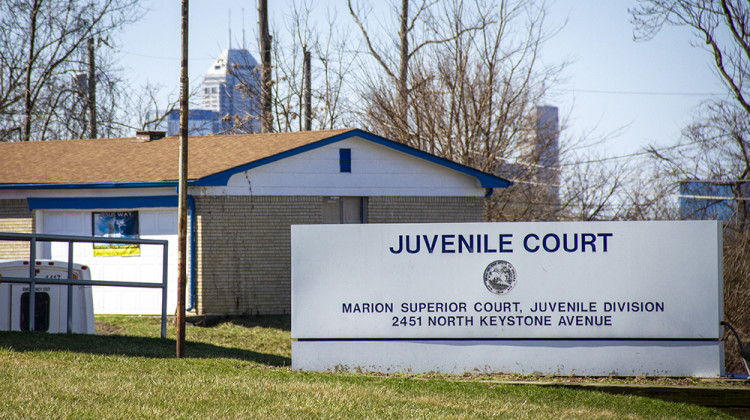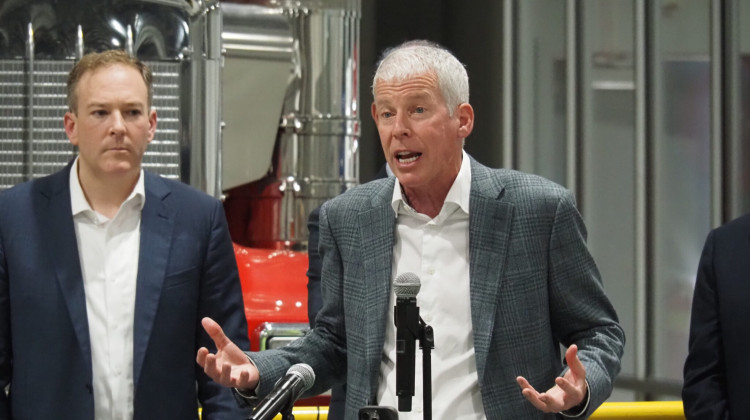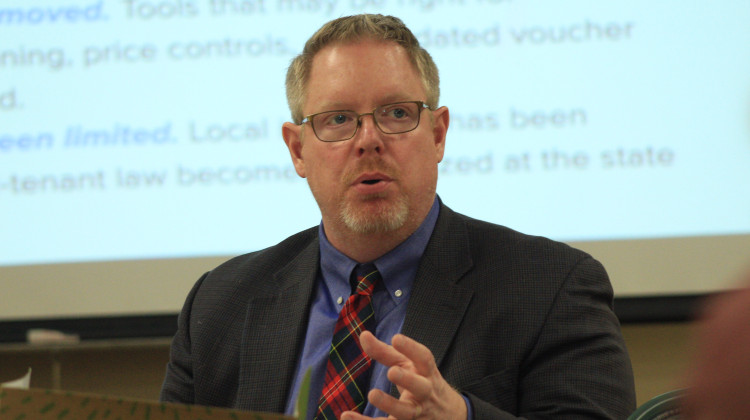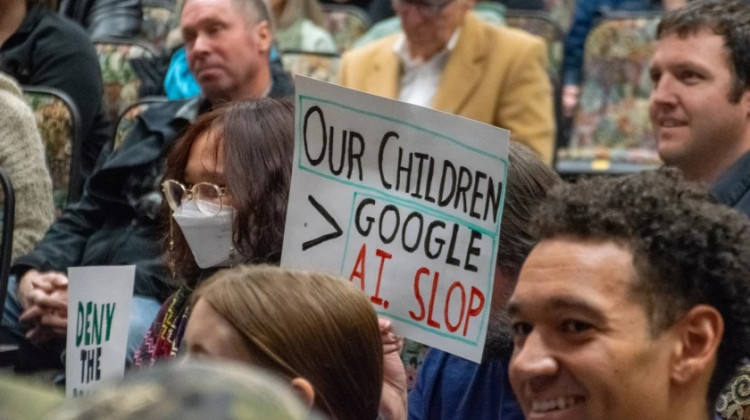
Indiana’s juvenile justice system is county-based, meaning data collection methods, diversion tactics and justice policies differ from county to county. Legislation recently signed into law aims to create more consistency.
Doug Jaggers/WFYIRonnelle Collins was just 14 years old when he first encountered the juvenile justice system. He vividly remembers when the police ran toward him, pointing a gun.
“It was scary. Like real scary, everything was quiet for a second. And the next thing you know, you just hear somebody yelling at you, running after you with a gun to you. And it was just crazy.”
After the encounter, Collins was placed on probation and house arrest for an offense. He was living with his grandmother at the time and he couldn’t leave the home to help her with errands and tasks.
“I couldn’t even go out to the front porch,” he said.
Now, he’s 17 and works as a community engagement intern at the youth organization Voices Corp. in Fountain Square.
In his role at Voices, Collins speaks publicly to give a youth’s perspective on the justice system, and leads service projects to help community members. When he learned of legislation that would make multiple reforms across the system, he decided to testify at a meeting at the Statehouse where officials and lawmakers were deciding what should be in the bill.
Collins spoke about how while he was on probation, he and his family were often left lost and in the dark on how the justice system works.
“I was kind of nervous. I'm not gonna lie. But it wasn't all too bad. Once I actually got up there and started speaking, they just wanted my honest opinion,” he said.
Collins and other stakeholders across the state agree there are gaps in Indiana’s juvenile justice system. Experts say youth are detained more than they need to be, and practices and protocols differ from county to county.
One bill passed by the Indiana General Assembly and signed into law by Gov. Eric Holcomb aims to overhaul the system and create changes that lawmakers and community members say are long overdue.
What is HB 1359?
House Bill 1359 passed the General Assembly on March 2 and was signed by Holcomb on March 11. It was introduced in January by Rep. Wendy McNamara (R- District 76) following years of work and conversations.
The bill quickly moved through both chambers of the General Assembly with bipartisan support. All who testified at committee hearings were in support of the bill.
The new law will put multiple reform efforts into effect, including not detaining children under 12 years old when possible, using risk assessment tools to divert youth away from the system and collecting better data to track who is in the state’s system.
An oversight committee will be created to see over the changes and hold officials accountable.
You can read the full law here.
What needs to be fixed?
The Council of State Governments, a national nonpartisan group specializing in research and data, audited the state’s juvenile justice system and found gaps that HB 1359 hopes to address.
First, the system is county-based, meaning data collection methods, diversion tactics and justice policies differ from county to county. That creates a lack of consistency on how children experience the juvenile justice system. For example, one youth may be placed on probation for committing an offense in one county, and in another they may be placed in a secure detention facility for the same crime.
“Local control is great, but if we have such disparate treatment for people in the same category or class for doing the exact same thing, it could raise equal protection concerns,” said Joel Wieneke, a senior staff attorney with the Indiana Public Defender Council. “Just because this kid is living on one side of the county line, as opposed to the other, their punishment or treatment is going to be vastly different.”
Additionally, the majority of youth who are placed in secure detention have committed low to moderate level offenses.
“Some of the kids frankly, don't need to be in the system,” said Julie Whitman, executive director of the Commission on Improving the Status of Children in Indiana.
The law will create more consistency statewide in terms of how juveniles experience the justice system.The law ensures counties are using risk assessment tools to determine if a juvenile needs to be detained, and to only detain them when necessary and if the youth is a risk to the community.
The law will also improve data collection methods so officials can have a better idea of who is in the juvenile justice system. Currently, data collection varies and it’s difficult to track who is in the system, what they are in the system for, and where they end up.
“If we're able to track what's happening system wide and track each individual and follow them through the system, it'll create that pathway for future change,” Wieneke said.
Indiana does not have a minimum age to detain youth in secure detention facilities. Under HB 1359, law enforcement will not detain kids under 12 when possible. However judges can still choose to detain them if they think the child is a danger to society or there is nowhere else to place them.
Collins agrees this is an essential change.
“At 12, 13, we're just becoming teens, like we're still under age or underdeveloped,” he said. “We're starting to understand everything, but we're still getting into how the world works.”
While Collins was not placed in secure detention himself, he knows of others who have been and who were around the age of 12. He said while they were in secure detention, the majority of the other kids were older teens.
“So being in there with that older group, I just felt like it was just an overall bad experience," he said. "And like, it shouldn't be for somebody who's 12.”
How did this law come about?
Many agree that these changes have been needed for decades.
“It’s not needed right now, it’s been needed for a long time,” Wieneke said.
Kia Wright is the executive director of Voices, where Collins interns. She says she thinks the system is outdated and hasn’t kept up with other more progressive changes.
“I think we're in a different time. You know what I mean? And I don't know that [the system] has moved and adjusted and pivoted with the time. And I think that's what is happening now.”
The process to create the law started in 2019, when McNamara attended a CSG conference session.
McNamara said she knew CSG needed to look into Indiana’s juvenile justice system.
“As this presenter was talking, I'm like, we need to do this in Indiana,” she said.
Then in early 2020, amid the beginning of a pandemic, CSG audited the state’s juvenile justice system and interviewed stakeholders across the system. A reform taskforce was created by the Commission on Improving the Status of Children, which McNamara and Sen. Mike Crider co-chaired.
The taskforce included politicians, judges, attorneys and community leaders. They met remotely throughout 2020 and 2021. The taskforce met in December 2021 to vote on recommendations of what the bill should include.
“In the fall when the taskforce met, we took a vote on what we needed to fix and how we needed to fix it, and that's what House Bill 1359 is,” McNamara said.
Collins said he was consulted during the taskforce’s work, and he was able to participate in Zoom meetings to give input. CSG also spoke with other youth who had been involved in the system.
Christine Kerl is the chief probation officer of Marion County and served as a member of the taskforce.
“Having this huge stakeholder group really participate, to see it come to actually being placed out there for consideration is very empowering,” she said.
There will be more legislation next year for funding to be allocated toward the bill’s efforts. Indiana’s legislature operates on a biennium schedule, meaning every other year is a budget year.
Unlike most laws, HB 1359 will take years to implement. While the law technically has an effective date of July 1, McNamara said it will take years for the law to take full effect.
“Once we have all the data processes in place, it would be my hope that by 2028, really, all 92 counties are on the same page,” she said.
An overhaul or a start?
Some, like McNamara, consider the law to be an overhaul of the system.
“I would describe it as an overhaul,” McNamara said. “When we did the deep dive into looking at the state, we looked at every corner and every factor. And if you look at this bill, it deals with the beginning, middle and end of a juvenile's touch with the juvenile system.”
However others see it as a first step in a long process to reform the system, but an important one.
“It feels like a really good start,” Wright said. “I hope that they're in for the long haul of this because even with the groundwork being laid with these recommendations, I don't think we're going to start to see the fullness of it for years to come. And I think this gives us the foundation to do more of the deeper work that needs to happen.”
Wieneke says many of the changes created are more like suggestions, leaving it up to each county to decide how far they want to take the reforms. The only absolute part of the law is not detaining kids under 12 when possible.
“I don't think it's a radical change. But it does provide very significant opportunities for change.” he said.
Work still needed
Once it comes time for the law to be implemented, some say it may be difficult to get all of Indiana’s 92 counties on the same page.
The law will allow for more grant opportunities and funded programming for counties to tap into, but Wieneke says it will be difficult to get wrap-around services in rural areas, especially when it comes to mental health professionals.
“I'm concerned about whether or not we have the providers that are willing to work in those communities to build those programs to make that shift,” he said.
Dena Carson, a professor at Indiana University-Purdue University Indianapolis agreed that rural areas are often left out of the picture.
“We tend to ignore rural areas a little bit when it comes to that and just looking at like a map of the juvenile detention centers like a lot of they're all near big cities and so the further you get away from a big city the less resources they're gonna have in terms of helping kids,” Carson said.
Additionally, the law only provides reintegration support to youth who were in DOC custody as they come back to their community after being detained. Wieneke says that is a very small percentage of kids who are in the system, with others in local secure detention centers or residential facilities.
The law will provide youth with a three-month program, which Wieneke says is less than the nationally recommended amount.
“The national success stories kind of center around doing this reintegration work for about a year. So it's a lot less than that,” he said.
Wright said she thinks the age of 12 is still too young to detain children.
“It's happening younger and younger,” she said. “We're starting to see an increase in delinquent behavior and things like that. I don't know what the magic age would be, it just still feels young. I mean, they're just now getting into middle school.”
Next steps
To start the implementation of the law, an oversight committee will be created to monitor the changes. It is unclear who will be on the committee, but members will be appointed by the Indiana Supreme Court Chief Justice.
Wright said it’s important that youth and community members are at the table, not just professionals.
Collins said he thinks there's more opportunity for police to build trust with youth in the community. He says when he has encountered police, they have been aggressive toward him.
“I feel like there's no such thing as a bad kid, you can always influence, help and teach kids to do different and to be better,” he said.
Many say that despite the creation of the law, there is still more work to be done.
“I'm excited to see them dig into the work to see how it translates, because you can have all of your ideas, but is policy going to support that, is the infrastructure going to support some of the changes?” Wright said. “So that's what I'm eager to see next, but I'm definitely hopeful. Definitely hopeful.”
Contact WFYI criminal justice reporter Katrina Pross at kpross@wfyi.org. Follow on Twitter: @katrina_pross.
Pross is a Corps Member of Report for America, an initiative of The GroundTruth Project.
 DONATE
DONATE









 Support WFYI. We can't do it without you.
Support WFYI. We can't do it without you.